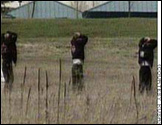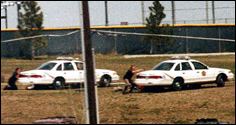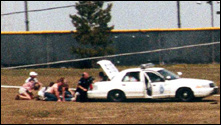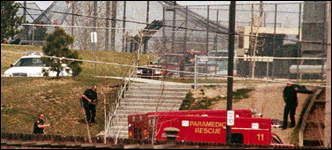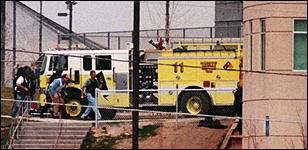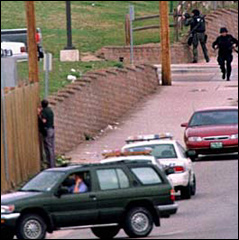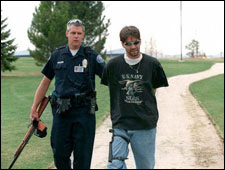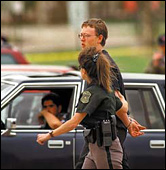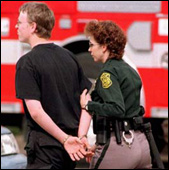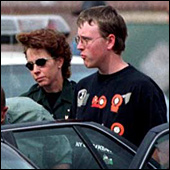
+ + + + + + + + + + + + + + +
"Mark Mershon, who now heads the Denver FBI office, said his SWAT team was one of at least six sent to the school, and it also followed orders from Jefferson sheriff's commanders. He said his team was ready to go at 1:45 p.m. but did not begin a search of the school until an hour later."
-- The Daily Camera
-- The Daily Camera
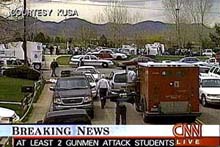 The Denver SWAT took a lot of heat from various sources. From news media to local law enforcement, people were accusing them of not moving in quicker and not approaching the situation more aggressively. They wanted to secure the perimeter, those in charge said; they weren't sure what was going on. So, they did not mobilize until it was far too late to do anything to stop the massacre.
The Denver SWAT took a lot of heat from various sources. From news media to local law enforcement, people were accusing them of not moving in quicker and not approaching the situation more aggressively. They wanted to secure the perimeter, those in charge said; they weren't sure what was going on. So, they did not mobilize until it was far too late to do anything to stop the massacre. Local police who arrived on the scene first sprang into action immediately. Jefferson County Sheriff's Deputy Neil Gardner, a community resource officer at Columbine High School and member of the bike patrol, was closest to the school and the first to arrive on scene. As soon as he stepped out of his patrol car, Eric Harris fired ten shots at him. Gardner had been in active shooter situations twice before, but had never returned fire. That day he did. He fired four shots at the gunman. Eric's gun jammed and he retreated into the school's upper level.
Gardner's backup arrived in the forms of Deputy Paul Magor and Deputy Paul Smoker. Deputy Scott Taborsky and Deputy Rick Searle arrived shortly after. Gardner and the additional officers continued to exchange fire. At 11:27 am, Gardner radioed in requesting emergency and medical assistance.
He and the other officers continued to keep radio communications going, reporting what they saw and heard as they battled the two shooters. They did their best to shield students and faculty from the gunfire as they fled the school, forming a chain of patrol cars for the evacuated to hide behind as they escaped.
By 11:30 there were six deputies on the scene when reporters began to show up at the school. In their haste to get the "scoop" some of the media vehicles hopped curbs and parked on the grass. About that time the shooters had made it to the library and, killing Kyle Velasquez on their way to the west windows, they began shooting out at the deputies from there. The paramedics arrived on-scene next. Medical workers leapt into the fray; despite the fact that they were being shot at, they dragged students out of the line of fire so they could be transported away from the scene where they could be treated. Deputies provided cover fire for them and eventually the shooters ceased fire and retreated.
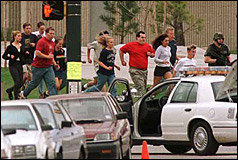 Lieutenant Terry Manwaring was the first of the SWAT personnel to arrive. He was on-scene at 11:38 a.m. Jefferson County Sheriff's Department set up a staging area at Pierce Ave and Leawood near the school. When they arrived, Undersheriff John Dunaway appointed Lt. David Walcher as incident commander. They sent out a call for any available SWAT to come to the scene.
Lieutenant Terry Manwaring was the first of the SWAT personnel to arrive. He was on-scene at 11:38 a.m. Jefferson County Sheriff's Department set up a staging area at Pierce Ave and Leawood near the school. When they arrived, Undersheriff John Dunaway appointed Lt. David Walcher as incident commander. They sent out a call for any available SWAT to come to the scene.The first Jefferson County SWAT team to assemble was a group of 12 officers from three different agencies who were thrown together during the crisis under the command of Manwaring. Many had never met before that moment. Most didn't even have their tactical gear or equipment with them. Denver SWAT Captain Vincent DiManna arrived on the scene with four other SWAT members. His son was a student at Columbine High and possibly still trapped inside. SWAT sniper Sean Dugan had a daughter who attended the school as well. She wasn't responding to his texts. They had clearance from incident commander Lt. Walcher to enter the school as soon as they were ready.
The confusion of conflicting reports they were receiving contributed to their slow reaction. They couldn't figure out how many shooters there were or where they were. All they knew for sure was that there were shooters in the school and people - children - were being shot at. It was nearly 12:00 PM - an hour after they were called to the scene - before they were ready to approach the school. Several lacked bullet-proof vests and they only had two riot shields with them. They were relying on a hastily-drawn map that a student sketched for them. The team used a fire truck to provide cover while they moved in close to the building.
A request was radioed in for an armored vehicle to be sent down to rescue the injured as the officials now in charge pronounced the area unsafe for medical. Despite restrictions, Littleton paramedics braved the unsafe conditions to rescue victims Sean Graves, Lance Kirklin, and Anne Marie Hochhalter, who had been gunned down outside the school.
Manwaring split his team in two, appointing SWAT member Allen Simmons as leader of the other team. Manwaring's group provided cover while Simmons' group headed to the school's east entrance, though though there had not been any gunshots or explosions heard from inside the school for nearly an hour. They inched closer to the building, alert to the possibility of a sniper on the roof or a hostage situation inside. At 12:06, Simmons' team entered the far east side of the school. They systematically broke down doors and searched each room, evacuating anyone hiding there before moving on to the next room.
Deputy Del Kleinschmidt drove the fire truck around to the school's west side where they saw two students prone in the grass, a girl and a boy. The boy was waving one of his arms. The SWAT team approached them behind the cover of the fire truck. They could only take the truck as far as the sidewalk. Capt. DiManna and Lt. Pat Phelan rescued Richard Castaldo, putting him on the front bumper of the fire truck before returning for Rachel Scott. They got her to the fire truck before they realized she was dead, at which time they left her in the grass. Richard was moved to Deputy Taborsky's car while the SWAT team went to rescue Dan Rohrbough. Discover he, too, was dead, they relayed the information to the deputy. Taborsky left to take Castaldo to triage. At around 12:30 Sergeant Barry Williams's team of 10 SWAT members arrived on-scene. At 12:50 they borrowed a front-end loader from a nearby construction company and used it as a makeshift armored vehicle to approach the school. Two SWAT members were deployed to take to the nearby neighborhood rooftops to keep watch on the southern parking lot, library, and cafeteria. A "live bomb" outside the cafeteria prevented them from entering the school that way. The west entry was considered a "hot zone". So, the team entered the building through the broken window that led to the teacher's lounge next to the commons. It was 1:09 p.m.
Half of Williams' team stayed by the cafeteria exits just in case the suspects tried to escape that way. The other half proceeded to investigate the kitchen and storage areas, again going door by locked door, breaking in and evacuating traumatized people. It would be hours before they made it to the area where the shooters were last active.
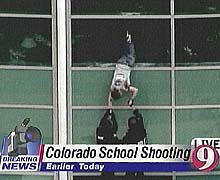 From the sidelines, news cameras could easily pick up the sign one student held up desperately pleading for aid for a dying Coach William "Dave" Sanders. He had been shot around 11:30 AM and students had been calling 911 repeatedly from that time for help. They were promised by dispatchers that help was on the way. But it wasn't. Coach Sanders bled to death on the floor of one Columbine's Science classroom. He was the last individual to die in the school and his family later maintained that he would not have died if the SWAT hadn't taken so long getting to him.
From the sidelines, news cameras could easily pick up the sign one student held up desperately pleading for aid for a dying Coach William "Dave" Sanders. He had been shot around 11:30 AM and students had been calling 911 repeatedly from that time for help. They were promised by dispatchers that help was on the way. But it wasn't. Coach Sanders bled to death on the floor of one Columbine's Science classroom. He was the last individual to die in the school and his family later maintained that he would not have died if the SWAT hadn't taken so long getting to him.The SWAT was forced into decisive action at 2:30 when, to save himself from the same fate Coach Sanders was enduring, Patrick Ireland rolled himself out of the library window. He would have fallen head-first two stories onto a concrete sidewalk if the mobile armored unit hadn't rolled in to catch him. However, if he had waited in the library for help to arrive he likely would have died there waiting.
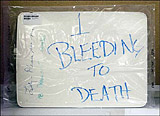 The SWAT team finally reached the critically injured Coach Dave Sanders at around 2:40, over three hours after Sanders was shot. When they arrived, students had put together a make-shift gurney with the intent to move the Coach out themselves as they'd given up hope on a rescue. The SWAT refused to let them use the gurney and made the students leave the building at that time. Two SWAT team members stayed with Sanders to wait for the paramedics.
The SWAT team finally reached the critically injured Coach Dave Sanders at around 2:40, over three hours after Sanders was shot. When they arrived, students had put together a make-shift gurney with the intent to move the Coach out themselves as they'd given up hope on a rescue. The SWAT refused to let them use the gurney and made the students leave the building at that time. Two SWAT team members stayed with Sanders to wait for the paramedics."While the world cheered as they watched television images of children escaping unharmed from the school, the two SWAT deputies with Sanders decided to move him closer to an exit route. After waiting for what they estimated to be 20 to 30 minutes, they decided a paramedic was not coming or could not get in, and that they would need to evacuate the wounded teacher themselves or at least move him closer to an exit.
"Their plan was to take him out a door over to the staircase, down the stairs through the cafeteria and out the side door, basically following the same route as the students just evacuated. They put Sanders on a chair so that they could move him easier and pushed him through the back doors of the science rooms into a storage area. Before they could move him from the storage room, a Denver paramedic arrived in the room. He had entered through the west side of the school and past SWAT where he was directed to Sanders. He advised the deputies that there was no pulse and, therefore, nothing more they could do. Dave Sanders had died."
- Quoted from CNN's in-depth info about the SWAT at Columbine High School
* Last shots officials exchanged with shooters: 12:04 p.m.
* Shooters commit suicide: 12:08 p.m.
* Patrick Ireland rescued after he rolls himself out of the library window: 2:38 p.m.
* SWAT team reaches Dave Sanders: 2:48 p.m.
* SWAT team finds Harris and Klebold dead in the library: 3:30 p.m.
The SWAT team penetrates the school at 1:09 PM. It was an hour after the shooters committed suicide that people were
released from the rooms next to the cafeteria but the SWAT wouldn't make it up to the library directly above till 3:22 PM.
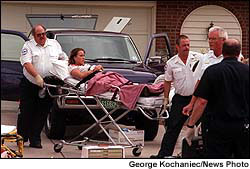
Paramedics move the injured, rushing them off to various hospitals around Denver.
After the majority of the survivors have been freed from Columbine's bloody halls the
FBI and bomb squad move in to investigate, starting with the cars in the parking lot.
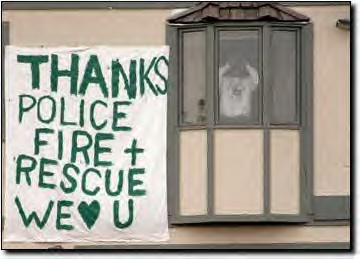
Neighbors living near the school hang a banner thanking those who helped.
"Their plan was to take him out a door over to the staircase, down the stairs through the cafeteria and out the side door, basically following the same route as the students just evacuated. They put Sanders on a chair so that they could move him easier and pushed him through the back doors of the science rooms into a storage area. Before they could move him from the storage room, a Denver paramedic arrived in the room. He had entered through the west side of the school and past SWAT where he was directed to Sanders. He advised the deputies that there was no pulse and, therefore, nothing more they could do. Dave Sanders had died."
- Quoted from CNN's in-depth info about the SWAT at Columbine High School
* Last shots officials exchanged with shooters: 12:04 p.m.
* Shooters commit suicide: 12:08 p.m.
* Patrick Ireland rescued after he rolls himself out of the library window: 2:38 p.m.
* SWAT team reaches Dave Sanders: 2:48 p.m.
* SWAT team finds Harris and Klebold dead in the library: 3:30 p.m.
|
An ambulance protects officers exchanging shots with the shooters inside the school. |
A firetruck acts as a shield for emergency workers to get close to the school. |
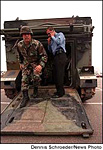 An armored unit is brought in. |
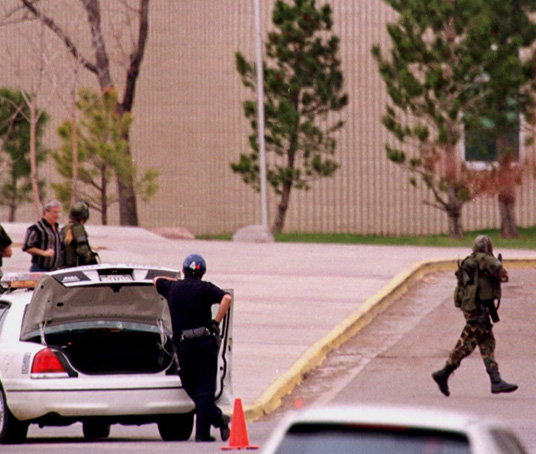 The Denver SWAT team, securing the perimeter. | This policeman watches the school from the far end while the SWAT scrambles by to... secure the perimeter. |
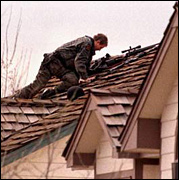 |
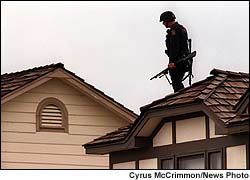 |
| SWAT team members, still securing the perimeter, this time from across the street. | |
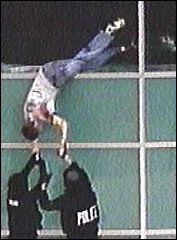 | The SWAT team is forced to take the armored unit up to the school when Patrick Ireland, shot three times (twice in the head), rolls himself out of the library window in order to escape the school and avoid bleeding to death waiting for help to arrive. |
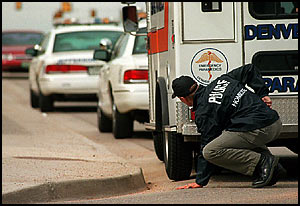 Police keep an eye on Columbine. |
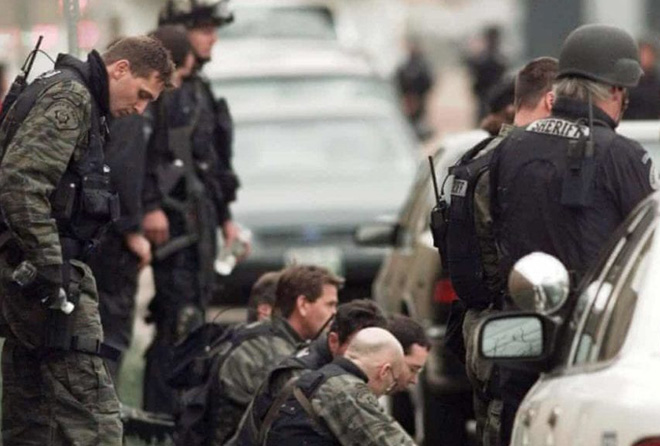 The SWAT, taking a break. |
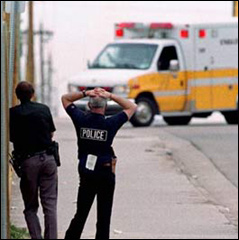 Police watch as the paramedics arrive. |
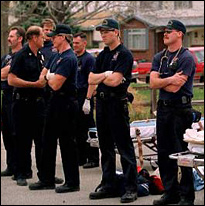 Paramedics wait for officials to allow them to treat the wounded. |
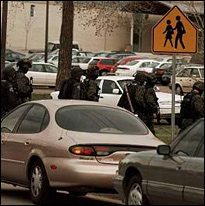 |
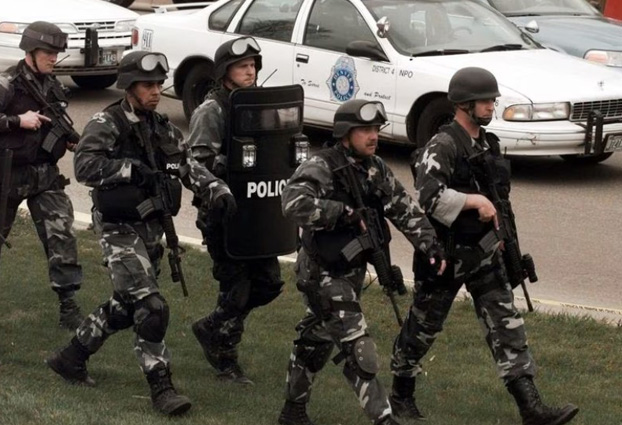 |
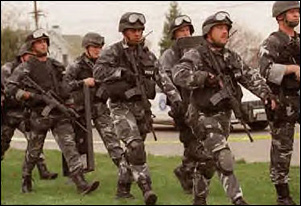 |
released from the rooms next to the cafeteria but the SWAT wouldn't make it up to the library directly above till 3:22 PM.

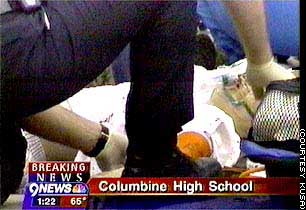 |
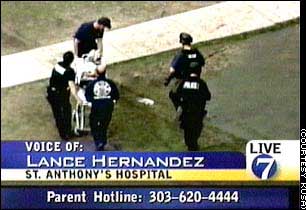 |
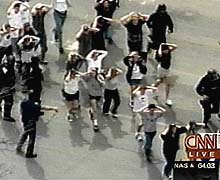 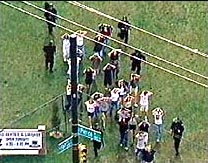 |
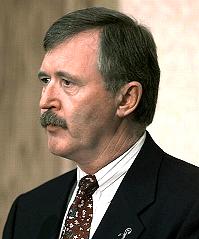 Sheriff John Stone of the Jefferson County Sheriff's Department. |
The New York Times ran a report: Terror in Littleton: the Police Response. The following is excerpted. Randy Patrick, a veteran officer from Westminster, a suburb of Denver, called the SWAT response "pathetic," and told The Denver Post, "I think they should have been more dynamic." The question is whether a specially trained unit could have entered the school immediately and perhaps saved more lives. The police have not said whether SWAT team members fired shots at the gunmen. They have speculated that the gunmen could have been dead for up to two hours after television seemed to show the school still under siege. It has since been released that the SWAT were under orders from their superiors not to fire on the building or its occupants. They didn't enter the school till nearly 2 hours exactly after the shooters committed suicide. ABCNews asked soon after the shootings: Did the Rescue Take Too Long? Coach Sanders' family thought so. They sued JeffCo and the Denver SWAT, citing their response time as directly contributing to his death. Since the shootings of April 20, 1999, Jefferson County, Denver, and many other locations all over the United States have changed their policies for how to deal with school shootings. They've added new training programs and spread awareness that this sort of incident is NOT going to be an isolated one. All across the world societies are having to cope with higher risks and the law enforcement bureaus say they're stepping up to the challenge. Time will tell. |
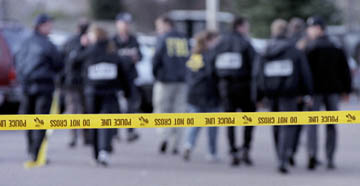 |
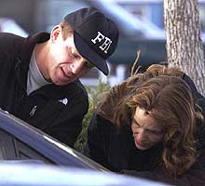 |
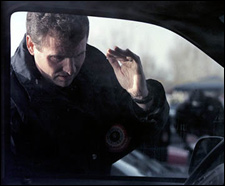 |
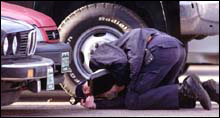
|
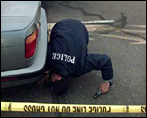 |
FBI and bomb squad move in to investigate, starting with the cars in the parking lot.

Neighbors living near the school hang a banner thanking those who helped.
